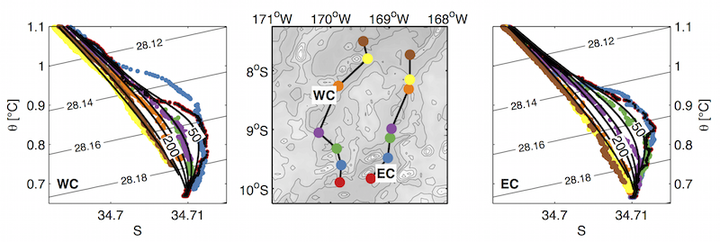
Abstract
The flow of dense water through the Samoan Passage accounts for the major part of the bottom water renewal in the North Pacific and is thus an important element of the Pacific Meridional Overturning Circulation. A recent set of highly resolved measurements used CTD/LADCP, a microstructure profiler, and moorings to constrain the complex pathways and variability of the abyssal flow. Volume transport estimates for the dense northward current at several sections across the Passage, calculated using direct velocity measurements from LADCPs, range from $3.9\times10^6$ to $6.0\times10^6$ $\pm1\times10^6$ m$^3$ s$^{-1}$. The deep channel to the east and shallower pathways to the west carried about equal amounts of this volume transport, with the densest water flowing along the main eastern channel. Turbulent dissipation rates estimated from Thorpe scales and direct microstructure agree to within a factor of two, and provide a region-averaged value of $\mathcal{O}$(10$^{-8})$ W kg$^{-1}$ for layers colder than 0.8°C. Associated diapycnal diffusivities and downward turbulent heat fluxes are about $5\times10^{-3}$ m$^2$ s$^{-1}$ and $\mathcal{O}$(10) W m$^{-2}$, respectively. However, heat budgets suggest heat fluxes 2-6 times greater. In the vicinity of one of the major sills of the Passage, highly resolved Thorpe-inferred diffusivity and heat flux were over ten times larger than the region-averaged values, suggesting the mismatch is likely due to undersampled mixing hot-spots.